Identifying Thai restaurant types before you even step inside
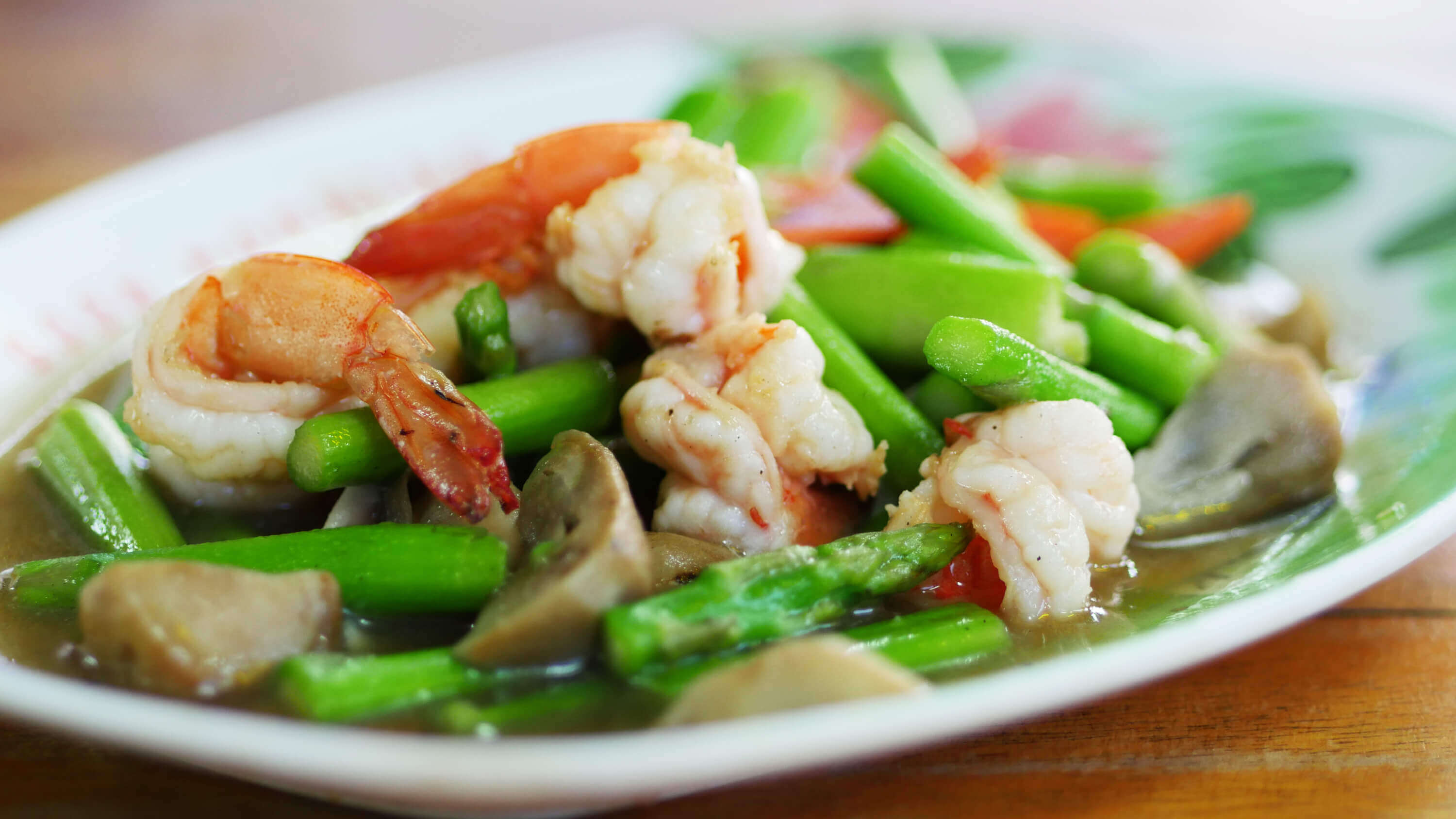
Here's how you can identify what dishes a restaurant or food cart in Thailand serves, even from across the street
Thai food is a huge draw for a lot of travelers coming to see what Thailand is all about. There’s an insane variety of mouthwatering food everywhere you look, and it’s sold from boats, baskets, bikes, trucks, carts, markets, roadside hole in the wall places, and of course more typical restaurants. Along the tourist trail, you’ll usually find an English menu, but step just a tiny bit outside the bubble and it can get difficult pretty quickly. Of course, that’s where most of the tastiest and most authentic food is. This Thai food guide shows you how to identify the most common restaurant types just by looking at them from outside.
Using this Thai food guide
It can be intimidating stepping into these places and trying to order, especially since you often have no idea what you’re actually going to end up eating. We know because we’ve been there. Now however, after all these years living in Thailand we can usually tell exactly what any restaurant or food cart serves, even from across the street. It’s actually fairly easy to identify the most common restaurant types, and after reading this Thai food guide you should be able to do so pretty easily.
Noodle shops

The different types of noodles on the bottom shelf of the glass case let you know this is a noodle shop.
The quickest, most convenient and easiest to find food type in Thailand is the noodle shop. These are absolutely everywhere and they’re very easy to identify if you know what to look for. Almost all Thai noodle shops have a glass case, and a large steaming cauldron of broth which may be covered in a big stainless steel lid. This is often built into the cart, but can also be a large pot nearby on a burner or over a pot of hot coals.
The glass case will have the different noodle types on the bottom shelf. The most common ones are sen lek – thin white rice noodles, and ba mee – yellow wheat and egg noodles. Above the noodles are the meats and sometimes some vegetables. There may be a shelf with trays that can hold cooked chicken drumsticks, cooked chunks of pork or beef, bags of various meatballs, dumplings, chunks of congealed pork blood, and other ingredients. Above this there may be some hanging loins of red pork or crispy pork – either of which is sliced off thinly to order. There may also be a roast duck hanging there.
Restaurants serving Thai stir fried dishes
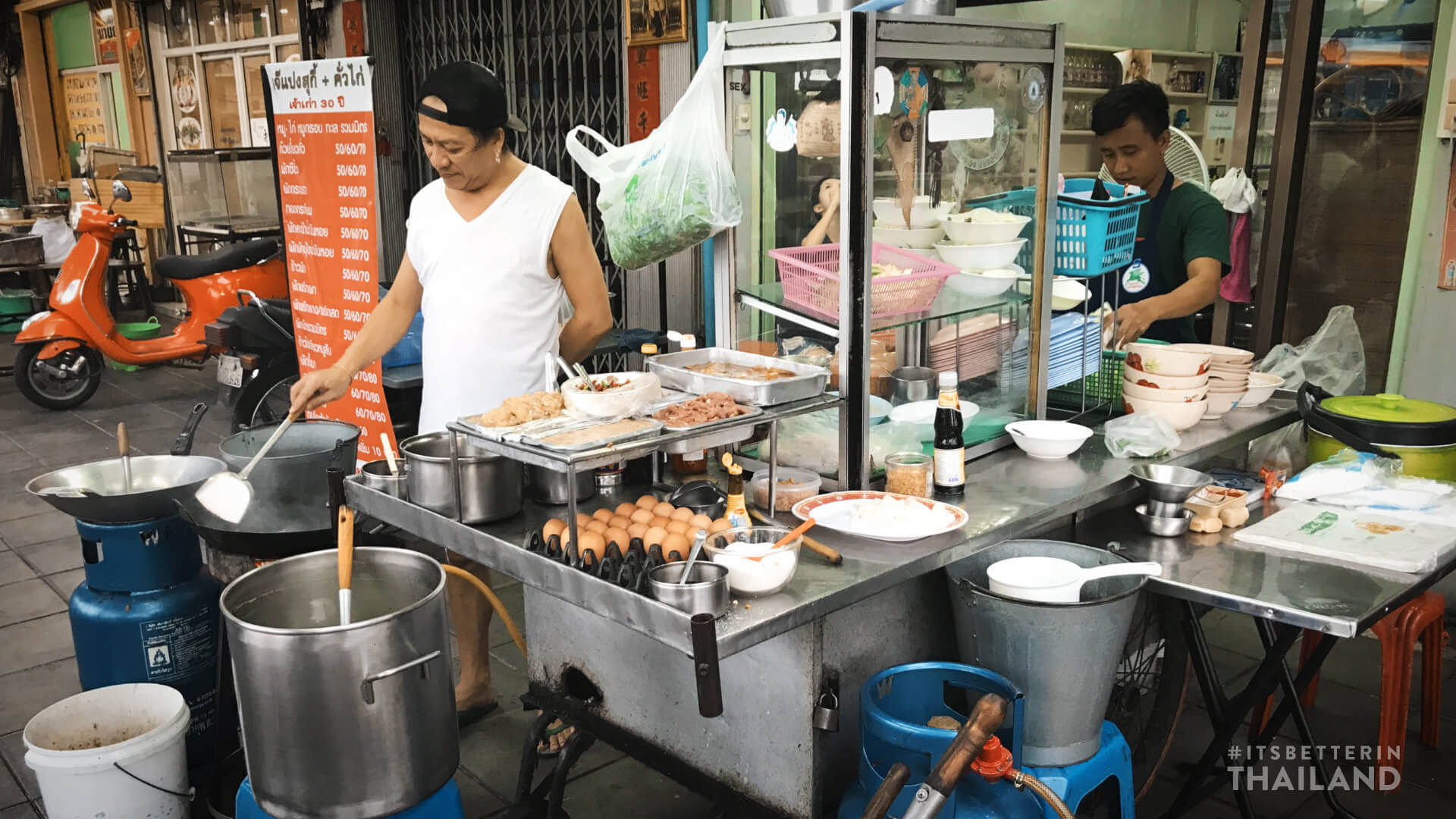
Woks usually mean stir fries. The meats and tray of eggs are another strong clue
Probably the next most common restaurant type is called ran ahaan dtam sang – made to order restaurant. These places usually do quick stir fried dishes that are served over rice. You can identify them by the wok, although sometimes you have to come closer to see if there is one. A wok on a burner (or several of them) is an almost sure sign that a place does stir fries to order. These restaurants usually have a glass case similar to noodle restaurants, but they won’t have the bags of different noodles on the bottom (unless they also serve noodles which is fairly common).
The most popular things to order at these restaurants would be:
- pad kra praow – meat of your choice stir fried with chili, garlic and Thai basil
- pad prik geng – meat of your choice stir fried with red curry paste and usually pieces of long bean
- pad kana – Chinese kale stir fried in oyster sauce with garlic and a couple of chilis. Make it next level by adding crispy pork to it
- khai dao – add this on to the end of your order to get a fried egg with it.
Curry shops
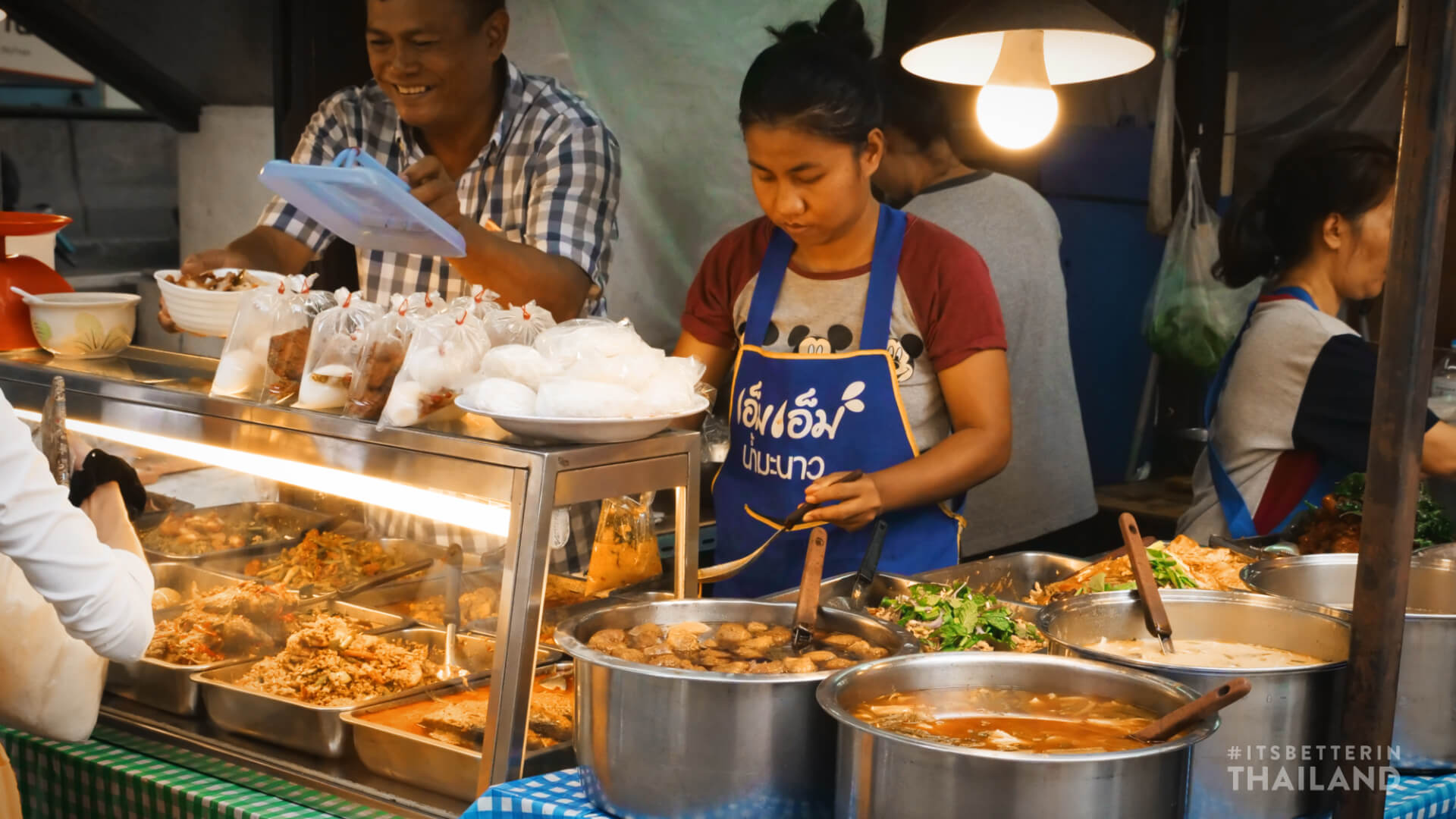
The trays in the case on the left are more common, but sometimes a restaurant uses pots, with or without a lid.
Khao geng literally means rice curry and is a common Thai restaurant type, usually for breakfast and lunch. These places have pre-made dishes in rectangular metal trays. The front of the shop will have a long and not very tall glass case with the trays laid out inside of it. Despite the name, not all of the dishes are usually curries. It’s typical to order a plate of rice with either one, two or three dishes served in a small portion on top (or in a small bowl if there are soups). You can also order larger portions of each dish and a plate of rice if you’re hungry or sharing between people.
Most of these restaurants make their food fresh every morning and sell out by early afternoon. In markets and other places with odd hours you can also find freshly made food late at night. In general if a place looks busy it’s probably fine to eat. At places like bus stations, or when a place looks quiet and still has a lot of food left in the evening, it may be best to avoid it. Also, the further out of cities you get, the stranger the dishes will get and the stronger the flavors. Picky eaters and those that don’t eat things that are spicy, fishy, smelly or strong tasting might have a hard time at curry shops in rural areas.
Papaya salad shops
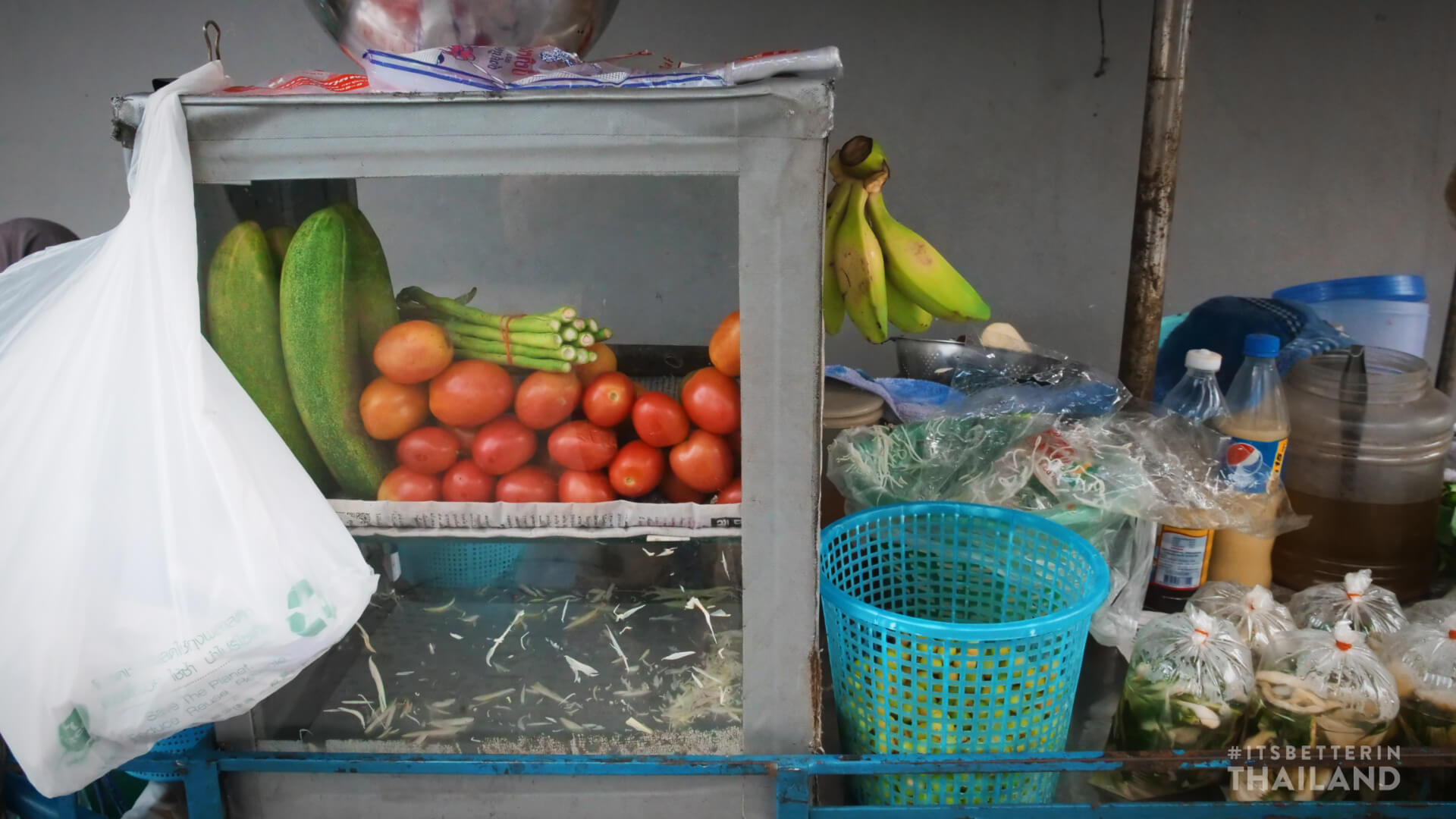
The scraps of shredded papaya on the bottom are a good clue, but the tomatoes, cucumbers and long beans are a dead giveaway. Papaya salad served here.
Most Thai people’s favorite food is som tum – green papaya salad. Unripe papayas are julienned or hacked off in thin slices making a fairly bland but nicely crunchy vegetable. This is mixed in a deep wooden or ceramic mortar with various ingredients to make a salad that is a mix of savory, sour, spicy and sweet. Everyone likes theirs different and there’s no limit to the combinations you can order. You can ask for more or less spicy, sour, or any other flavor. Any type will have fish sauce, palm sugar, and spicy birds-eye chilis unless you specify otherwise.
Papaya salad places will have the same type of glass case as noodle and stir fry restaurants, but inside there will be green papayas, a bunch of smallish tomatoes, and possibly some cucumbers and corn. Behind this will be at least one large mortar and pestle.
The most common ways to serve som tum are:
- som tum Thai – served with a few tomato halves, a bit of julienned carrot, pieces of long bean, peanuts, and small dried shrimp. The least adventurous eaters should order this one and ask for no shrimp by saying mai sai goong heng.
- som tum poo-pla-ra – like the above but without peanuts and shrimp, and with fermented crab and a sauce of old fermented fish. You need a high tolerance for fishy things to like this one, and foreigners who can eat it have a lot of street cred with Thais. Most restaurants use pla ra (the fermented fish) that has been cooked, but at some places, especially in the Northeast of Thailand they do not. Uncooked freshwater fish contain parasites that can live in your liver and eventually cause cancer. Northeast Thailand and Laos have the highest rates of this cancer in the world. The shop will be able to tell you whether theirs is cooked or raw.
- som tum dtaeng kwa – Just like som tum Thai except the papaya is replaced by cucumber pieces.
Issan (Northeastern) food restaurants
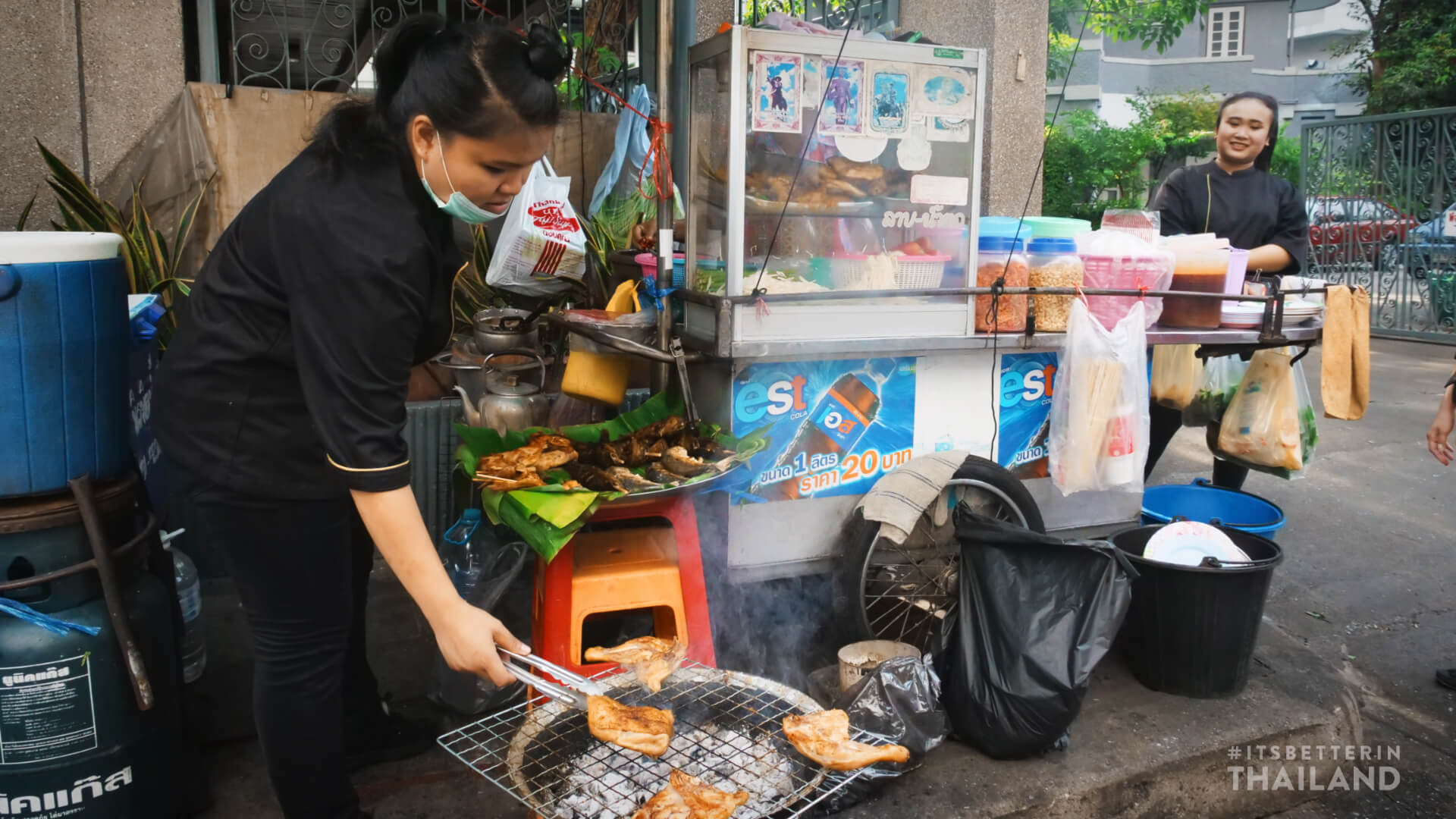
You can see the papaya salad ingredients in the glass case. All the grilled meats indicate the expanded Issan menu.
Some som tum shops only do the papaya salad, but others have full menus of Northeastern Thai dishes. Many papaya salad shops have meat slowly grilling over coals – usually chicken and catfish and sometimes pork. One of the great pleasures of eating in Thailand is munching on papaya salad, sticky rice and a grilled chicken leg. If the restaurant has a decent sized kitchen and it looks like they have more than just the salad mixing mortars, they likely do some other Isaan specialties as well.
The clues to look for are a few cheap metal saucepans which they use as mixing bowls, and a cutting board. If they have this they probably serve at least larb and nam tok – two delicious salads of meat mixed with herbs and spices. They may also have soop naw mai – a nice spicy salad of tender bamboo shoots (order without pla ra if you don’t like fishy flavors). And if they do it, you should try tom sap – the Isaan version of tom yum soup – spicy but delicious!
For Isaan food, if you want it made the way locals eat it, tell them you want it pet pet, sap sap – spicy and delicious.
Thai chicken rice
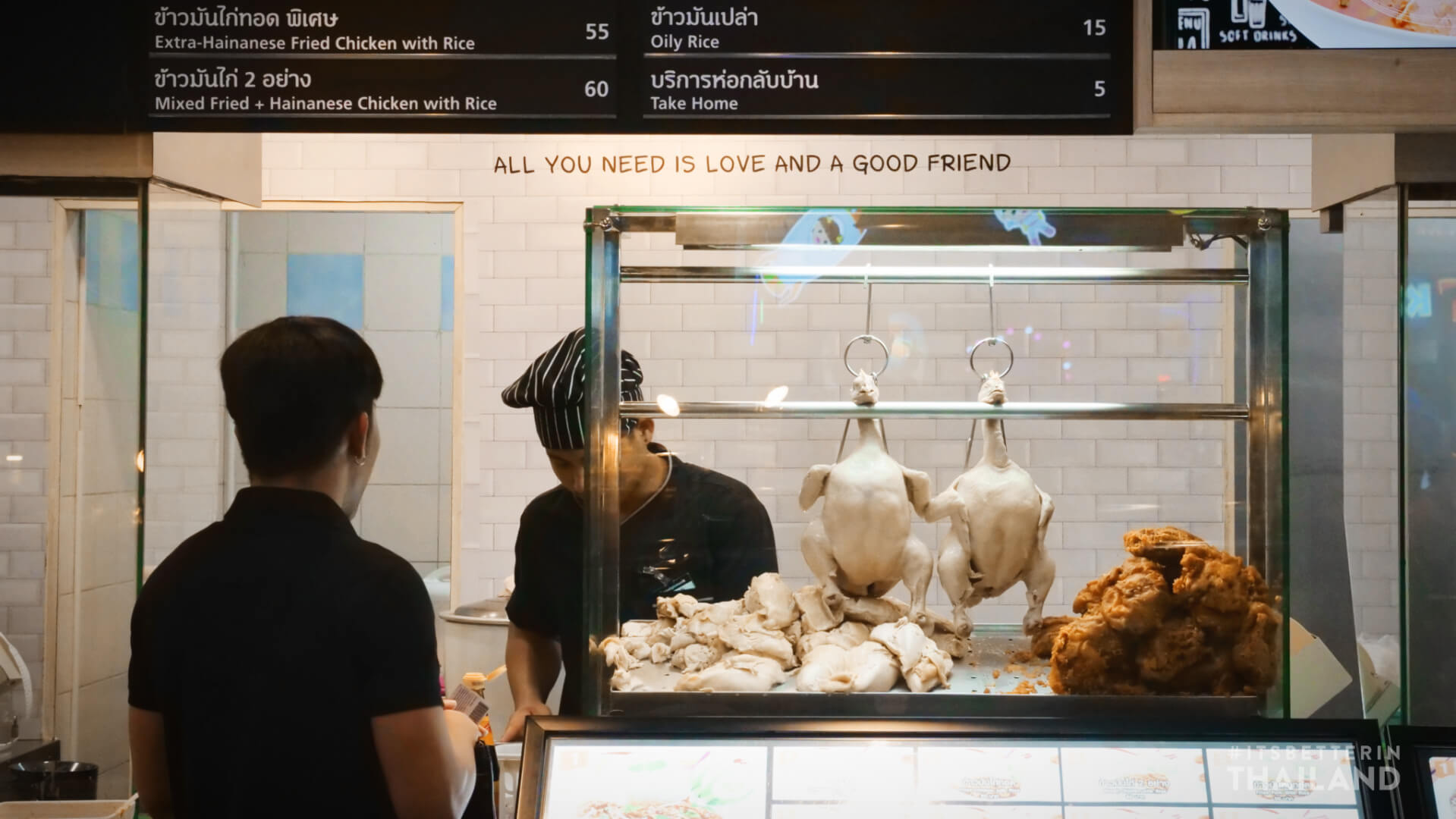
Whether on the street or in a mall food court, the glistening white chickens hanging behind glass always mean chicken rice.
Khao man gai is a simple but delicious dish whose name translates to ‘chicken fat rice’. Chinese immigrants from Hainan province have brought this dish with them all over Asia, particularly to Singapore and Thailand. The Thai version is always a plate with a scoop of rice that’s been cooked with a bit of chicken fat, some sliced pieces of chicken meat, a few slices of fresh cucumber, a small bowl of hot broth on the side, and a little cup of sauce. Every place in Thailand does their sauce differently – some are more spicy, others more mild. Some have ginger, others do not. Some restaurants, particularly in mall food courts have a few sauces available, but most street food places just have their one house sauce.
You can identify chicken rice restaurants because they have the usual glass case and there will be at least one whole boiled chicken hanging from the top. A boiled chicken is pretty light in color, don’t confuse it with a roast duck which is dark brown.
Grilled meat on a stick places

Moo ping, one of the best things you can eat in Thailand and the staple of the grilled meat on a stick vendor.
There’s not really a name for these places other than something equivalent to ‘the shop that sells grilled chicken/pork’. Sometimes these places have a selection of different meats on sticks, and sometimes they will sell a single item only. If it’s just the one thing, it’s usually a delicious snack called moo ping – a mix of pork meat and tender fat marinated in a sweet sauce. These shops will almost always sell sticky rice in a small bag, usually for 5-10 baht. moo ping is a very common meal on the go for Thais, especially in the morning. If you see someone on the side of the road in the morning with a grill on a small table, this is probably what they’re selling.
These places are obviously easy to identify because grilled meat on a stick is easy to recognize. Some places have a large variety of chicken, pork and beef sticks available. Note that places with a larger selection sometimes have some of the ‘nasty bits’ – intestines, liver, chicken ass etc. They’re great if you like those bits, not so much if you don’t. If you don’t know whether or not you like it, go ahead and give it a try.
Fried meat on a stick
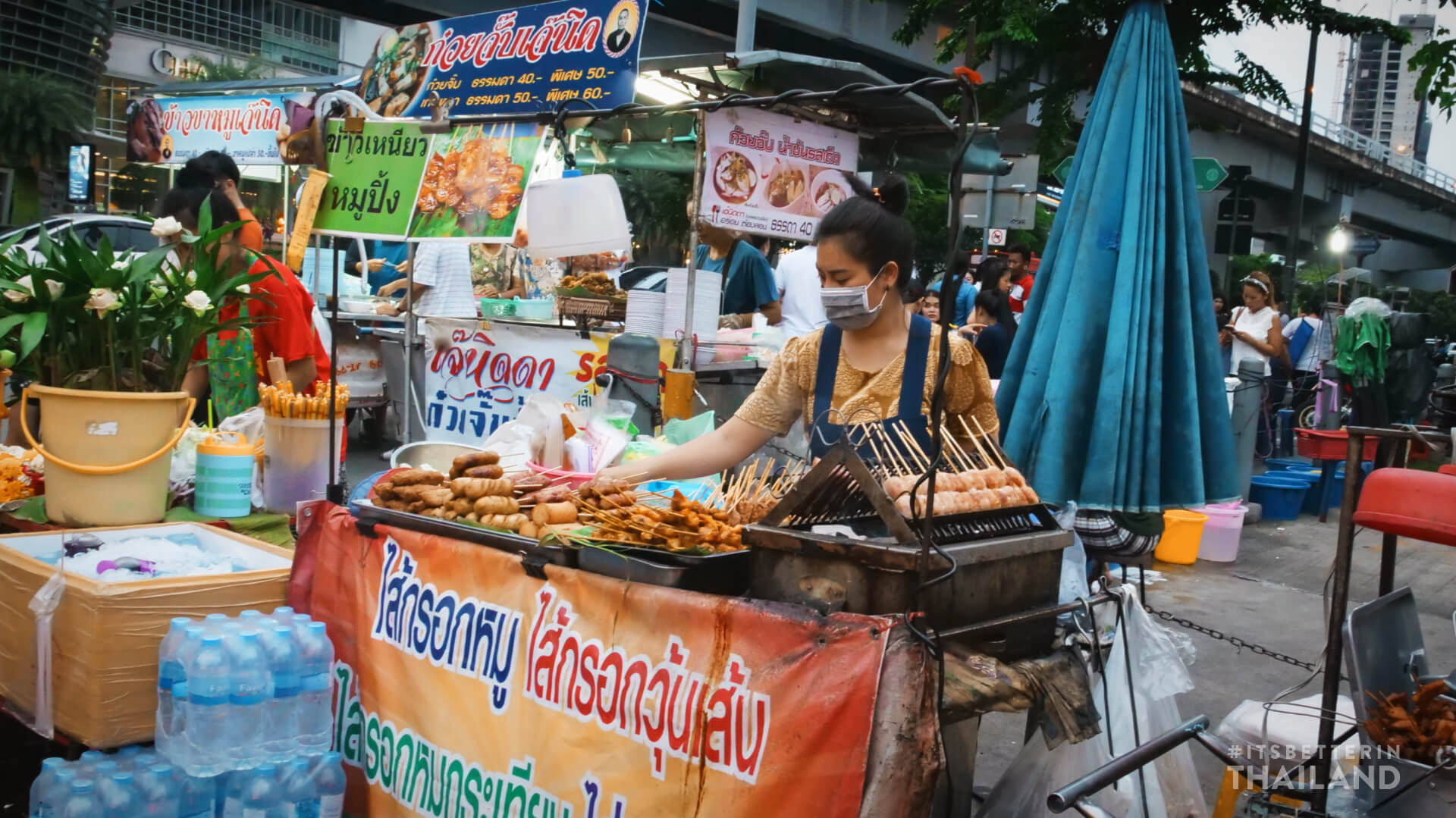
Grilled and fried meats on a stick. The typical look chin restaurant has more plastic-y looking hotdogs than this shop.
Some places sell meat on a stick in the form of balls, or look chin which is Thai for meatball. These places sell a variety of meatballs – chicken, pork, beef, fish – as well as various hotdogs, small wantons and other small meaty bits. These are not the healthiest snacks as everything typically gets deep fried. They are popular with students and you’ll almost always find someone selling look chin from a motorbike sidecar near schools in the afternoon. You choose your sticks, they’re fried, dumped into a plastic bag and have sauce poured in over them. Often they’ll have two or three sauce options available – usually one more spicy and one more sweet.
Note: You may have heard that street food is now banned in Bangkok. Don’t worry, it’s not. For a full explanation read our piece on the supposed Bangkok street food ban.
Be a bit adventurous and don’t worry too much
Most travelers new to Thailand approach eating at local places with at least some apprehension. We know, we’ve been there. Sadly, many never even really try, sticking to their guesthouse and the nearby restaurants catering to foreigners. It’s really easy to break away from this though. Use our Thai food guide as a reference, and just go. You don’t need to worry about offending anyone – if you step into a shop and don’t like the look of the food or feel too overwhelmed, just give a polite smile and leave. Thais are really friendly and understanding. In the places that don’t have any English menu, they might be more surprised if you sit and stay than if you leave.
Note that this is a rough guide to give you the basics. It would be impossible to cover the breadth of Thai cuisine in a single post, or even a lifetime of traveling and eating. This guide covers the most common restaurant types, but there are many more that can’t be described here. Also a lot of places might do a mix of these different foods. It’s not uncommon for a place to do stir fries and noodles. Chicken rice restaurants also do noodles frequently since they already have the simmering pot of broth.

Just order
Just go with the flow, smile a lot, don’t be afraid to try new things, and you’ll discover some amazing dishes that most other travelers miss. Most likely the worst that will happen is you won’t like something you’ve ordered so you and the cook will be slightly embarrassed. You can almost totally mitigate this with a friendly smile and the ability to laugh at yourself.
For a great resource check out Mark Wiens’ site Eating Thai Food. Get a leg up on finding great restaurants by using the local foodie app Wongnai – Check out our Thailand travel hacks guide for a quick section on how to use it plus lots of other great Thailand travel tips.
Get out there and EAT!
